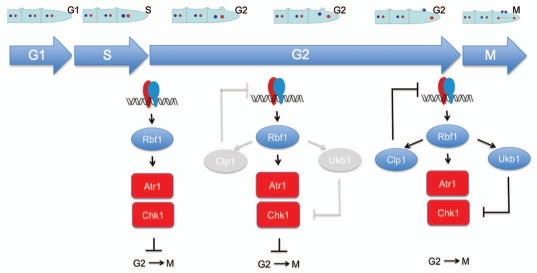Figure 1.
Hypothetical model of b-dependent G2 enlargement during dikaryon cell cycle. The b heterodimer activates a transcriptional cascade, which includes the Rbf1 regulator, resulting in the activation of the Atr1-Chk1 cascade. Chk1 inhibits the Cdc25 phosphatase resulting in a delay in G2/M transition, providing the expected enlargement of G2 phase required for the formation of clamp-like structures as well as the associated nuclear movements. During this enlarged G2 phase, the transcriptional activity of Rbf1 also generates the accumulation of two regulators: the Clp1 protein, which inhibits the b heterodimer; and the Ukb1 kinase, that is proposed to inhibit Chk1. Once these two regulators reach a threshold, the pathway is downregulated at transcriptional level (by Clp1-mediated inhibition of b heterodimer) as well as at the level of the signal cascade (by the Ukb1-mediated inhibition of Chk1), enabling the transition from G2 to M phase.

